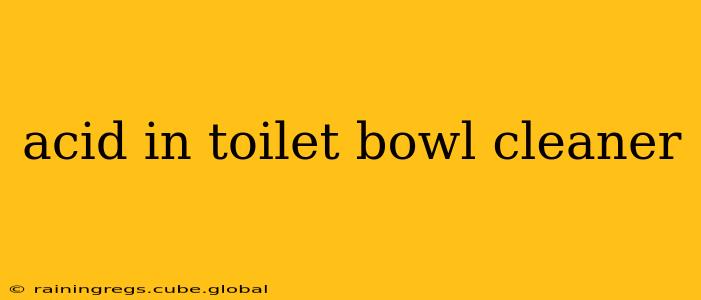Toilet bowl cleaners are designed to tackle tough stains and eliminate germs, but their effectiveness often stems from the presence of powerful acids. Understanding the types of acids used, their mechanisms of action, and associated safety precautions is crucial for safe and effective cleaning. This post will delve into the chemistry behind these cleaners, exploring common acids and addressing frequently asked questions.
What kind of acid is in toilet bowl cleaners?
The most common acid found in toilet bowl cleaners is hydrochloric acid (HCl), also known as muriatic acid. This strong acid is highly effective at dissolving mineral deposits like calcium carbonate (limestone) and magnesium carbonate, which are common culprits behind toilet bowl stains and build-up. Some cleaners also utilize sulfuric acid (H₂SO₄), another strong acid, though it's less prevalent than HCl. The concentration of the acid varies between brands, but it's always significantly diluted for safety reasons. Always check the product label for specific information on the acid content and concentration.
How does acid in toilet bowl cleaner work?
Acids work by donating protons (H⁺ ions) to the mineral deposits. This process, known as acid-base neutralization, breaks down the insoluble minerals into soluble salts and water. For example, the reaction between hydrochloric acid and calcium carbonate can be represented as:
2HCl(aq) + CaCO₃(s) → CaCl₂(aq) + H₂O(l) + CO₂(g)
This reaction produces calcium chloride (a soluble salt), water, and carbon dioxide gas. The soluble salt is then flushed away with the toilet water, leaving a cleaner bowl. The effectiveness depends on the concentration of the acid and the contact time with the deposits.
Is toilet bowl cleaner acid or base?
Toilet bowl cleaners are acidic. The presence of strong acids like hydrochloric acid or sulfuric acid makes them highly effective at dissolving mineral deposits, but also necessitates careful handling due to their corrosive nature.
What are the dangers of toilet bowl cleaner?
The strong acidic nature of toilet bowl cleaners poses several dangers:
- Chemical burns: Direct contact with the skin or eyes can cause severe burns.
- Inhalation hazards: The fumes can irritate the respiratory system.
- Ingestion: Accidental ingestion can cause serious internal damage.
- Mixing with other cleaners: Mixing toilet bowl cleaners with other cleaning agents, especially those containing bleach, can produce toxic gases like chlorine gas, which is extremely dangerous. Never mix toilet bowl cleaner with bleach.
Always follow the manufacturer's instructions carefully, wear appropriate protective gear (gloves, eye protection), and ensure adequate ventilation when using these products.
What happens if you mix toilet bowl cleaner with bleach?
Mixing toilet bowl cleaner with bleach is extremely dangerous and should be avoided at all costs. The reaction between the acid in the toilet bowl cleaner and the bleach (sodium hypochlorite) can produce toxic chlorine gas (Cl₂). Chlorine gas is a highly irritating and potentially lethal respiratory irritant. Even small amounts can cause serious health problems, including lung damage. Never mix these two types of cleaners.
How to safely use toilet bowl cleaner?
- Always read the label: Familiarize yourself with the instructions and safety precautions before using the product.
- Wear protective gear: Use gloves and eye protection to prevent contact with the skin and eyes.
- Ensure adequate ventilation: Work in a well-ventilated area to minimize exposure to fumes.
- Follow instructions carefully: Don't exceed the recommended usage amount or contact time.
- Keep out of reach of children: Store the cleaner in a safe, secure location away from children and pets.
- In case of accidental contact: Immediately flush the affected area with plenty of water and seek medical attention if necessary.
This information is for educational purposes only. Always consult the product label and seek professional advice if you have any concerns regarding the safe handling and use of toilet bowl cleaners.
